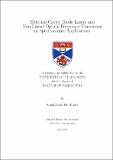External cavity diode lasers and non-linear optical frequency conversion in spectroscopic applications
Abstract
Semiconductor diode lasers are successful tools in atomic spectroscopy. They are routinely used in frequency conversion applications to develop devices that access regions of the spectrum not directly available. This thesis describes the practical application of novel violet diode laser systems and their possible inclusion in spectroscopic systems.
The design, assembly and successful operation of a doubly resonant optical parametric oscillator is described. There is discussion of the spectral behaviour of the device and the potential for pumping with a violet diode laser. Methods to adapt the output from the solitary diode devices are demonstrated with the use of microlensed diode lasers and extended cavity configurations. Details of the current tuning, linewidth and
smooth tuning characteristics of a number of the lasers used are given. A commercial
violet diode laser is used within an extended cavity to measure the hyperfine structure
of atomic indium from a hollow cathode galvatron source at room temperature.
Stabilisation of the diode laser to a line from the indium spectrum is attempted.
The remainder of the thesis is concerned with the development of techniques to deliver
clearer and more precise spectral information about trace species. Microlensed
red and violet diode lasers are used to generate light at 254nm via sum frequency
generation for the direct detection and modulation spectroscopy of mercury vapour,
with microlensed lasers with modulation allowing more accurate discrimination between
spectral features than direct absorption measurements. In addition Raman
tweezers modulation spectroscopy is undertaken to investigate polymer microspheres
and biological cell samples where the use of the modulation technique demonstrated
improvements in the acquisition time and clarity of spectra through increased signal
to noise and rejection of background fluorescence effects. A comparison between the
direct and modulation techniques for all the systems indicates the greater sensitivity
of the modulation technique.
Type
Thesis, PhD Doctor of Philosophy
Rights
Creative Commons Attribution-NonCommercial-NoDerivs 2.5 Generic
http://creativecommons.org/licenses/by-nc-nd/2.5/
Collections
Except where otherwise noted within the work, this item's licence for re-use is described as Creative Commons Attribution-NonCommercial-NoDerivs 2.5 Generic
Items in the St Andrews Research Repository are protected by copyright, with all rights reserved, unless otherwise indicated.


